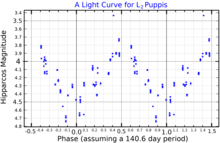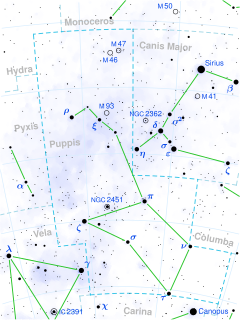L2 Puppis
| Observation data Epoch J2000 Equinox J2000 | |
|---|---|
| Constellation | Puppis |
| Right ascension | 07h 13m 32.31810s[1] |
| Declination | −44° 38′ 23.0630″[1] |
| Apparent magnitude (V) | 5.10[2] 2.6–6 (GCVS)[3] 6–8 (1995 – )[4] |
| Characteristics | |
| Evolutionary stage | Red-giant branch[5] |
| Spectral type | M5IIIe[3] |
| U−B color index | +1.24[2] |
| B−V color index | +1.56[2] |
| Variable type | SRb[3] |
| Astrometry | |
| Radial velocity (Rv) | 33.0[6] km/s |
| Proper motion (μ) | RA: 106.31[1] mas/yr Dec.: 324.99[1] mas/yr |
| Parallax (π) | 15.61 ± 0.99 mas[1] |
| Distance | 210 ± 10 ly (64 ± 4 pc) |
| Details | |
| Mass | 0.659±0.043[6] M☉ |
| Radius | 123±14[6] R☉ |
| Luminosity | 1,490±150[5] L☉ |
| Surface gravity (log g) | 0.078±0.027[6] cgs |
| Temperature | 3,500±250[6] K |
| Age | 10[6] Gyr |
| Other designations | |
| Database references | |
| SIMBAD | data |

(Credit: ESO/P. Kervella)
L2 Puppis (also known as HD 56096) is a giant star in the constellation of Puppis and is located between the bright stars Canopus and Sirius. It is a semi-regular pulsating star, and is intermittently visible to the naked eye.
History
[edit]The designation L2 has a tangled history. This star and another were both labelled with "L" by Nicolas-Louis de Lacaille when he created the constellation Puppis within Argo Navis.[7] The two stars were labelled as "1.L" and "2.L" by Johann Elert Bode in his star catalogue published in 1801.[8] Later authors used L1 and L2, usually with numeric subscripts (i.e. L1 and L2),[9] but occasionally as superscripts.[10] The subscripted designation is now universally used where typography allows for subscripts.[6][11]
L2 Puppis was discovered to be variable by Benjamin Apthorp Gould in 1872,[12] and was listed in Uranometria Argentina as 73 G. Puppis with magnitude 5.10v. It has never been given a formal variable star designation, unlike L1 Puppis which is OU Puppis.[13]
Variability
[edit]
L2 Puppis varies in apparent magnitude by about two magnitudes with a period of 140 days. The average brightness also varies slowly over several years so that the total range is given as magnitude 2.6–6.0. Since 1995 the average brightness has dropped so that the 140-day variations are now between about magnitude 6 and 8.[4][15] The variation in light may be caused by a combination of radial pulsations in the star's atmosphere and by dimming from circumstellar dust.[16]
Characteristics
[edit]L2 Puppis is most likely an red-giant branch star that has passed through the main sequence and is evolving to become a white dwarf.[5] It is shedding mass at the rate of about 5×10−7 M☉ per year, forming a circumstellar dust disk and bipolar plumes of gas that are thought to be the start of a "butterfly"-type planetary nebula.[6]
It has been calculated that the mass of L2 Puppis is currently about 0.66 M☉ and its original mass was close to one M☉ about 10 billion years ago.[6] Other calculations give higher masses, for example 2+1
−0.5 M☉, and younger ages such as 1.5 billion years.[11]
L2 Puppis has a visual 12th-magnitude companion. A hundred years ago, they were separated by about a minute of arc, but different proper motions mean that this is now about 1.5′.[17]
Candidate planet
[edit]A candidate exoplanet has been found orbiting L2 Puppis every 4.69 years at a distance of 2.43 AU. The mass is highly uncertain, at 12 ± 16 MJ, and it might just be a dense clump of gas and dust.[6]
References
[edit]- ^ a b c d e Van Leeuwen, F. (2007). "Validation of the new Hipparcos reduction". Astronomy and Astrophysics. 474 (2): 653–664. arXiv:0708.1752. Bibcode:2007A&A...474..653V. doi:10.1051/0004-6361:20078357. S2CID 18759600.
- ^ a b c Ducati, J. R. (2002). "VizieR Online Data Catalog: Catalogue of Stellar Photometry in Johnson's 11-color system". CDS/ADC Collection of Electronic Catalogues. 2237. Bibcode:2002yCat.2237....0D.
- ^ a b c Samus, N. N.; Durlevich, O. V.; et al. (2009). "VizieR Online Data Catalog: General Catalogue of Variable Stars (Samus+ 2007–2013)". VizieR On-line Data Catalog: B/GCVS. Originally Published in: 2009yCat....102025S. 1. Bibcode:2009yCat....102025S.
- ^ a b Lykou, F.; Klotz, D.; Paladini, C.; Hron, J.; Zijlstra, A. A.; Kluska, J.; Norris, B. R. M.; Tuthill, P. G.; Ramstedt, S.; Lagadec, E.; Wittkowski, M.; Maercker, M.; Mayer, A. (2015). "Dissecting the AGB star L2 Puppis: A torus in the making". Astronomy & Astrophysics. 576: A46. arXiv:1503.05031. Bibcode:2015A&A...576A..46L. doi:10.1051/0004-6361/201322828. S2CID 11845036.
- ^ a b c Uttenthaler, S. (2024-12-01). "The evolutionary state of the red giant star L2 Puppis". Astronomy & Astrophysics. 692: A224. arXiv:2411.13388. doi:10.1051/0004-6361/202452173. ISSN 0004-6361.
- ^ a b c d e f g h i j Kervella, P.; Homan, W.; Richards, A. M. S.; Decin, L.; McDonald, I.; Montargès, M.; Ohnaka, K. (2016). "ALMA observations of the nearby AGB star L2 Puppis - I. Mass of the central star and detection of a candidate planet". Astronomy & Astrophysics. 596: A92. arXiv:1611.06231. Bibcode:2016A&A...596A..92K. doi:10.1051/0004-6361/201629877. S2CID 55298073.
- ^ Coelum australe stelliferum ... H L Guerin & L F Delatour. 1763. p. 146.
- ^ Johann Elert Bode (1801). Allgemeine Beschreibung und Nachweisung der Gestirne: Nebst Verzeichniss der geraden Aufsteigung und Abweichung von 17240 Sternen, Doppelsternen, Nebelflecken und Sternhaufen:(zu dessen Uranographie gehörig). Selbstverl. p. 76.
- ^ Merrill, Paul Willard (1916). "Spectroscopic observations of stars of class MD". Publications of the Astronomical Observatory of the University of Michigan. 2: 48, 52. Bibcode:1916POMic...2...45M.
- ^ Williams, A. Stanley (1897). "Observations of southern variables in 1885–86". Astronomical Journal. 18: 72. Bibcode:1897AJ.....18...71W. doi:10.1086/102788.
- ^ a b Chen, Zhuo; Nordhaus, Jason; Frank, Adam; Blackman, Eric G.; Balick, Bruce (2016). "Three-dimensional hydrodynamic simulations of L2 Puppis". Monthly Notices of the Royal Astronomical Society. 460 (4): 4182. arXiv:1602.06142. Bibcode:2016MNRAS.460.4182C. doi:10.1093/mnras/stw1305. S2CID 119195190.
- ^ Innes, R. T. A.; Kapteyn, J. C. (1903). "Revision of the Cape Photographic Durchmusterung, Part II. Variable Stars, Miscellaneous Stars, etc". Annals of the Cape Observatory. 9: 18B, 48B. Bibcode:1903AnCap...9....2I.
- ^ Benjamin Apthorp Gould (1879). Uranometria Argentina: Brightness and Position of Every Fixed Star, Down to the Seventh Magnitude, Within One Hundred Degrees of the South Pole. Paul Emile Coni. p. 171.
- ^ "Light Curve". Hipparcos ESA. ESA. Retrieved 17 February 2022.
- ^ Bedding, T. R.; Kiss, L. L.; Kjeldsen, H.; Brewer, B. J.; Dind, Z. E.; Kawaler, S. D.; Zijlstra, A. A. (2005). "The light curve of the semiregular variable L2 Puppis – II. Evidence for solar-like excitation of the oscillations". Monthly Notices of the Royal Astronomical Society. 361 (4): 1375–1381. arXiv:astro-ph/0507471. Bibcode:2005MNRAS.361.1375B. doi:10.1111/j.1365-2966.2005.09281.x. S2CID 16797010.
- ^ Bedding, T. R.; Kiss, L. L.; Kjeldsen, H.; Brewer, B. J.; Dind, Z. E.; Kawaler, S. D.; Zijlstra, A. A. (August 2005). "The light curve of the semiregular variable L2 Puppis – II. Evidence for solar-like excitation of the oscillations". Monthly Notices of the Royal Astronomical Society. 361 (4): 1375–1381. arXiv:astro-ph/0507471. Bibcode:2005MNRAS.361.1375B. doi:10.1111/j.1365-2966.2005.09281.x. S2CID 16797010.
- ^ Mason, Brian D.; Wycoff, Gary L.; Hartkopf, William I.; Douglass, Geoffrey G.; Worley, Charles E. (2001). "The 2001 US Naval Observatory Double Star CD-ROM. I. The Washington Double Star Catalog". The Astronomical Journal. 122 (6): 3466. Bibcode:2001AJ....122.3466M. doi:10.1086/323920.

